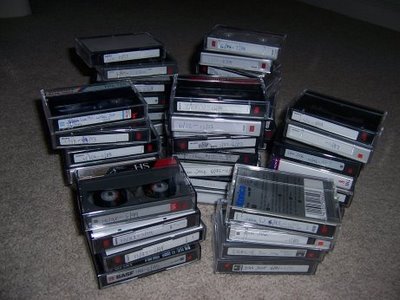skip to main |
skip to sidebar
The Web is making enormous changes in how market research is done. I just wrote about it on my other weblog, Stop Flying Blind, and thought some of you might be interested.

Welcome to the 37th Carnival of the Mobilists. If you're not familiar with the Carnival, it's a weekly collection of posts submitted by mobile-related weblogs. Each week is hosted by a different blogger. I have the honor of being this week's host.
The idea of the Carnival is to create more visibility for people doing commentary on the mobile industry. So please click on some of the fine articles below. You'll make a blogger's day.
What is a carnival anyway?
Say the word "Carnival" and you'll conjure up different images around the world. A Brazilian may think of incredible costumes and samba schools. Someone from the Caribbean is more likely to think of steel drum bands. An Italian might think of elegant masks in Venice.
Where I grew up, the word "carnival" brings to mind the sideshow of a traveling circus. The elephants and clowns were in the big tent, while the carnival was the place for the games (inevitably rigged so you couldn't win), rides (dangerously rickety), and oddities. No carnival was complete without a carnival barker, the guy who enticed people to pay to see the bearded lady and the man who ate radio parts.
Which type of Carnival are we running this week? Maybe a little of each...

Samba time. About the closest thing to a samba school in mobile-land is the ongoing debate over the fate of mobile data. Will it ever really take off? Is there a killer app? Like a samba school, the discussions are almost endless and very complex, and it seems like the same schools of thought come up again year after year.
The mobile mono-culture. Stephanie Rieger writes a very interesting commentary on regional differences in culture, and asks why despite the diversity of the world's cultures, so many mobile games and content are the same worldwide. She suggests we need infrastructure that enables much easier creation and distribution of locally-produced content. Amen.
Let the users create their own content. This one isn't strictly mobile, but I think it's interesting in light of Stephanie's post. Anders Borg discusses how user-generated content can sustain an online community, even in the face of big competitors.
Will mobile TV be a killer app? Kevin Evans is a newcomer to the Carnival, and he starts off with a nice article summarizing some of the danger signs surrounding mobile TV. Is it another SMS, or another WAP?
What if you built a smartphone and nobody cared? Steve and Rafe over at All About Symbian mix it up on the subject of whether smartphone users know they can add applications, whether they should care about it, and whether that will change in the future. It's a good discussion, and a subject near and dear to my heart.

Beautiful noise. In the hierarchy of musical instruments, the steel drum isn't very high up. Mozart never composed for it, and you don't see a lot of them in the world's great orchestras. But even though they don't get much attention, they make a beautiful noise. I'm not quite sure how to draw an analogy from this to the mobile market, but maybe our equivalent of steel drums would be the mobile devices that aren't mobile phones. They're not always as well publicized as the phones, but they have their own special charms.
The better $100 PC. David Beers injects himself into the $100 laptop PC debate with a post suggesting that a dockable mobile phone might be a much better investment for the developing world. He makes an interesting case, and he apparently got some pointed replies from $100 PC supporters after Robert Scoble flagged his earlier comments on the subject.
I'm reminded of a conference I went to earlier this year, where there was a speaker who's active in education for developing countries. He was asked about the $100 PC, and his response was to gently suggest that it might be nice to buy those kids a few books first.
Goodbye LifeDrive? If you follow the online rumors, the Palm LifeDrive has been reported close to extinction more often than the spotted owl. The saga continued this week as Palm reportedly has stopped shipping the LifeDrive to Europe because it includes hazardous substances that are no longer legal in the EU. Tam Hanna asks whether this signals the end of the LifeDrive.
iPod RIP. By far the best cat fight of the week is the discussion spawned by Tomi Ahonen's lengthy post declaring the death of the iPod at the hands of the MP3-capable phone. "The battle is totally over. Apple cannot recover," he writes. Tomi makes the mobile-phone-conquers-all argument very forcefully and in great detail. Check it out and decide for yourself.

Elegance and sophistication. What could match the elegance of a Venetian masked ball? I'm not sure, but most of us would agree that the average mobile phone user interface doesn't come close. A couple of posts supported that point this week.
Is it a bug or a feature? MobHappy talks about mobile phone usability this week, noting a recent study which reported that 63% of the mobile phones returned as defective actually have nothing wrong with them. (Or that is to say, whatever's wrong with them was designed in deliberately.) The post discusses why this happens, what it costs the industry, and what we should do about it.
Mobile interface and Google's mobile plans (not). MoJordy reports on a recent seminar on mobile Web trends. The speakers were from GotoMedia and Google. The Google discussion, unfortunately, was focused more on what's wrong with the industry rather than what Google plans to do about it. Still, there were some very interesting tidbits.

The Sideshow. Ladies and gentlemen, boys and girls, step right up to see the most amazing, the most colossal, the most spine-tingling posts in the mobile world this week. (Well, actually these are just the posts that didn't fit into the other three categories.) I must warn you, ladies and gentlemen, some of these posts might provoke or amuse you, and if you're not careful you might actually learn a thing or two.
Tagging on the go. MPulse is creating a tagging and content aggregation system for mobile Web content, and building some interesting functionality into it. MoPocket has a very nice overview of the product, complete with lots of screen shots, something that I really appreciate in any product discussion.
MinuteWatcher vs. TMobile. Darla Mack comments on TMobile's recent decision to block access to Minute Watcher, a service that tracks mobile phone usage. She feels it's not a self-serving move by TMobile.
Skepticism about the hosted Blackberry server. Enough of this consumer stuff, let's talk mobile enterprise. Daniel Taylor is very skeptical about the ability of RIM's new hosted Blackberry server product to increase Blackberry sales in small and medium businesses.
Barcode status. The Pondering Primate discusses the status of various standards for phone-readable barcodes.
Unimpressed with Motorola's mobile plans. Strong disappointment about the new phones coming from Motorola was expressed by Tarek Speaks Mobile.
Will the operators control the mobile Internet? It just wouldn't be a carnival without a little gratuitous nudity, and Open Gardens provides it along with an interesting commentary on the speculation that "naked" SIP will outsell IMS in the mobile world, undercutting the operators' ability to control and tax the mobile Internet.
Post of the week
As host of the Carnival, I get to choose a post of the week. The winner gets acclaim, and is eligible to be voted the Post of the Month, which carries a $250 prize from Khosla Ventures. Tomi's iPod post is definitely the most passionate (and longest), Stephanie's was very insightful, and I really like the way Kevin Evans thinks. But the point-counterpoint at All About Symbian was my favorite, so that's the post of the week. Congratulations, guys!
Next week, the Carnival will be at Howard Rheingold's SmartMobs. See you there!
[PS: If you subscribe to the RSS feed from my site, you may have received multiple copies of this post. I apologize -- Blogger has been giving me some formatting trouble. Again.]
The infamous flaming Dell laptop finally made the mainstream press this week, with an article in the New York Times. If you somehow missed the original story, a Dell laptop did a Burning Man imitation at a conference in Japan. Someone took pictures (let's hear it for camera phones), and the photos made it onto the Inquirer web site. From there they spread all over the web, and eventually to the Times.
The Times views the burning laptop as a parable about Dell customer service, but actually if it's a parable about anything, it's on batteries and our attitudes toward technology. Most of us don't realize just how much energy has been packed into the average mobile device battery. If you release that energy all at once, it can easily cause a nasty fire. A company called Valence, which says it has less dangerous battery technology, distributes fun information on exploding batteries:
Here's a picture of a mobile device battery bursting into flame:

And here's a quote:
"In the last two years alone, the US Product Safety Commission has received approximately 83 reports of incidences of cell phones exploding and/or catching fire injuring consumers due to their batteries. One incident was reported by Curtis Sathre who said 'It was like a bomb going off. His 13-year-old son Michael stood stunned, his ears ringing, hand gushing blood and body covered in black ash. In a split second, fragments from Michael's exploding cell phone had hit him between the eyes and lodged in the ceiling of the family's home in Oceanside, Calif.'"
Four or five years ago, I attended a tech conference called Power. It was a meeting of the leading battery technology companies in high tech. I was there to talk about the future of mobile devices and to tell them what we needed from future batteries. (Our message: more, more, more. Their message: wait for fuel cells. I'm still waiting.)
One of the other speakers was a guy from Dell, and he showed a picture of a laptop that had been destroyed by a battery fire. Cracked screens, blackened plastic, etc. Nasty stuff. He asked, "what if this happens on an airplane?"
(Good question. I hope the answer is that a flight attendant would grab a fire extinguisher and put out the fire, but it would be an unpleasant and dangerous situation, especially since the battery is feeding on its own energy when it burns.)
Anyway, the point being made by the Dell guy was that mobile battery technology needs incredibly stringent quality controls, far beyond typical quality standards. One failure in a million would have laptops and phones melting down every week. The failure rate needs to be more like one in a billion, which is an incredibly difficult task. Meanwhile, we keep on trying to cram as much energy as possible into our mobile devices.
Just one failure in a bad place, the Dell guy said, could hurt the whole industry. Despite a lot of scares since then, the explosive battery story has never really taken off with the general public. People view the incidents as isolated quality control issues, rather than what they really are – symptoms of a technology being pushed to the edge. I don't know if the exploding notebook in Japan will be the crossover event that makes people pay more attention, but it's interesting to see it in the mainstream media. Fortunately, this fire wasn't on a plane.
The lesson in all of this? I think it's given best by one of the photos from the Inquirer website:
 Check out the guy in he left foreground. While the Dell burns itself out, he's typing away on his own laptop.
Check out the guy in he left foreground. While the Dell burns itself out, he's typing away on his own laptop.
The fact is that we aren't going to give up our mobile devices, so we're all going to live with some risk. But please be careful about buying off-brand lithium ion batteries. You want to get them from a company that's obsessive about quality control.
I'm taking a detour from mobility this week to ask a question: Do you own a video camera?
If you have kids, like me, chances are you bought video camera before or soon after your first child was born, so you could preserve those precious childhood moments. Like me, you probably took dozens of hours of video in the first year – the little one smiling when her toes were tickled, the little one sucking on daddy's thumb, the little one spitting creamed carrots across the room.
Over the subsequent years, as you accumulated more and more tape – more than 100 hours of it in my case – you probably started to ask yourself an important question:
Why did I buy a video camera when I never watch the videos?
 My video collection
My video collection
Watching unedited home video is only slightly less tedious than watching old episodes of Mayberry RFD. The ratio of interesting sequences to boring ones is unpredictable, and it's impossible to remember which tape has that great clip when Uncle Jack's toupee caught fire. You spend hours searching and only minutes watching.
The usual answer to this is that you're supposed to digitize that video and edit it.
Sure.
Video editing is probably the most unpleasant thing you can do with a computer (other than your taxes). It's slow, tedious, and difficult. For a while I thought the problem was just that I was using the wrong program, but now I've edited video on a PC and on a Mac. I've used iMovie and Pinnacle and Final Cut. I know how to work them all, and I can make pretty good videos with them. But the process of actually editing video using any tool is pure torture because the basic act of sorting through video and deciding what to do with it is tedious. There's no way to fix it.
To explain the seriousness of the problem, here's how I think editing home video compares to having dental work done:
Dental work: Sit in a comfortable chair and listen to your iPod.
Editing video: Sit in an uncomfortable chair and watch the same 30 seconds of video over and over while you try to set the in and out points correctly.
Dental work: Someone picks at your teeth with a sharp instrument, but at least you know roughly when it'll be over.
Editing video: That two-hour digitization session failed because you selected the wrong format. Start over.
Dental work: Before they drill, you get anesthesia.
Editing video: You feel every second of it.
Dental work: You like looking at your smile in a mirror.
Editing video: You never want to see any of your relatives again.
It makes you wonder why people keep buying video cameras. But hey, there's another baby born every minute.
So here I am with a drawer full of 8mm videotape, and my wife has ordered me to stop using the video camera because we never watch the tapes.
The answer: Don't edit the video
Because video editing itself is the problem, I think the only way to solve it is to find a way to make home video useful without any editing at all. One approach is to get software that does the editing for you, like Muvee. I haven't had a chance to try it, but my sense is that it's aimed more at creating a video from a particular event like a birthday party, rather than bringing to life a whole video archive, which is the thing I want to do.
I'd like to propose a different approach, which involves a new device I'll call a video frame.
The video frame is an LCD screen that you can put on a table or wall, just like a picture frame. Many of these devices already exist for electronic still pictures. They're called "digital frames," and they come from companies like Ceiva, Pacific Digital, and Philips. They generally cost $100-$200, and they can hold as many photos as you can put on a memory card.
Although many of these products can display video, the user has to do all the editing, and then put the video clips on a memory card that goes into the frame. That's no better than what we have today. What I want is a frame that doesn't require you to edit the video. You just plug the camera's S-video port into the video frame, hit play, and the whole tape is transferred into the frame's memory. You repeat the same process with another tape, and so on, until your whole video collection is in there. No editing, no reviewing, all you have to do is plug in a cable and hit Play repeatedly.
The video frame identifies the transitions between scenes and separates them (this a normal function for a lot of video software). Hang it on the wall, and it starts playing scenes from your video collection at random. The effect is like a random walk through family memories. You're walking down the hall one day and you'll see your son's third birthday party where he buried his face in the cake. The next day you'll see your dog when she was a puppy and climbed into the laundry basket. And so on.
Video collections sometimes accidentally include scenes that you don't want to see again – for example, I have video of my son getting hit by a pitch at a little league baseball game. I don't really need to see that again, and neither does he. So we'll have a "don't show this again" button on the side of the frame. Touch it when you see a scene that you don't like, and it'll be removed from the rotation. (The thing I like about this is that we still get the effect of edited video, but now it's a gradual process you do fairly painlessly, rather than a lengthy torture session.)
Video cameras today generally include time and date information with the video, so our frame could be set up to do some cool things – for example, you could set it to show video that matches the time of day in the real world. So you'd get sunset scenes at sunset, that sort of thing. Or you could have it match the season of the year, so you'd see lots of Christmas or Hanukkah video in December, but not in July.
I could picture video frames pre-loaded with environmental video. For example, how about random scenes of Tahiti? That would be great for soothing people in the waiting room of a doctor's office.
Cost is an issue
A video frame needs a processor capable of doing MPEG-4 compression on the fly, and a substantial hard drive to store the video. I'm not sure what that would cost today, but I'm certain the price will go down over time – both processors and disk storage are strongholds of Moore's Law. If this product isn't affordable already, it's just a matter of time until it is.
When I was between jobs last fall, I tried to talk this idea around to people in Silicon Valley. It actually got a much better reaction than the info pad note-taker idea I wrote about a few weeks ago. People understood the video frame concept immediately, and all of the ones who had home video cameras wanted it. Unfortunately, we also all agreed that there's probably very little a video frame that you could patent, and so there's little incentive for a startup to invest in it.
But it would be a great add-on product for a video camera company. So listen up: Sony, Matsushita, Canon, I want you to steal my idea. Please build me a video frame and I promise I'll go back to using my video camera. I might even buy a new one.
But until then, the camcorder stays in storage, and I'll concentrate on taking still photos that I can actually do something useful with.







